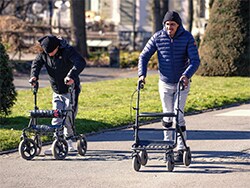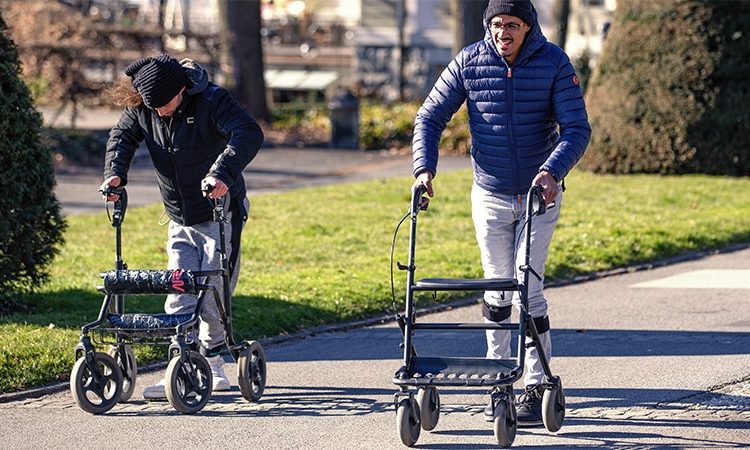A breakthrough neuromodulation system rapidly restores motor function in patients with a severe spinal cord injury (SCI), new research shows.

The study demonstrated that an epidural electrical stimulation (EES) system developed specifically for spinal cord injuries enabled three men with complete paralysis to stand, walk, cycle, swim, and move their torso within 1 day.
“Thanks to this technology, we have been able to target individuals with the most serious spinal cord injury, meaning those with clinically complete spinal cord injury, with no sensation and no movement in the legs,” Grégoire Courtine, PhD, professor of neuroscience and neurotechnology at the Swiss Federal Institute of Technology, University Hospital Lausanne, and the University of Lausanne, told reporters attending press briefing.
The study was published online February 7 in Nature Medicine.
More Rapid, Precise, Effective
SCIs involve severed connections between the brain and extremities. To compensate for these lost connections, researchers have investigated stem cell therapy, brain-machine interfaces, and powered exoskeletons.
However, these approaches aren’t yet ready for prime time.
In the meantime, researchers discovered even patients with a “complete” injury may have low functioning connections and started investigating epidural stimulators designed to treat chronic pain. Recent studies ― including three published in 2018 ― showed promise for these pain-related stimulators in patients with incomplete SCI.
But using such “repurposed” technology meant the electrode array was relatively narrow and short, “so we could not target all the regions of the spinal cord involving control of leg and trunk movements,” said Courtine.
With the newer technology “we are much more precise, effective, and more rapid in delivering therapy.”
To develop this new approach, the researchers designed a paddle lead with an arrangement of electrodes that targets sacral, lumbar, and low-thoracic dorsal roots involved in leg and trunk movements. They also established a personalized computational framework that allows for optimal surgical placement of this paddle lead.
In addition, they developed software that renders the configuration of individualized activity-dependent stimulation programs rapid, simple, and predictable.
They tested these neuro-technologies in three men with complete sensorimotor paralysis as part of an ongoing clinical trial. The participants, aged 29, 32, and 41 years, suffered an SCI from a motor bike accident 3, 9, and 1 year before enrollment.
All three patients exhibited complete sensorimotor paralysis. They were unable to take any step, and muscles remained quiescent during these attempts.
A neurosurgeon implanted electrodes along the spinal cord of study subjects. Wires from these electrodes were connected to a neurostimulator implanted under the skin in the abdomen.
The men can select different activity-based programs from a tablet that sends signals to the implanted device.
Personalized Approach
Within a single day of the surgery, the participants were able to stand, walk, cycle, swim, and control trunk movements.
“It was not perfect at the very beginning, but they could train very early on to have a more fluid gait,” said study investigator neurosurgeon Joceylyne Bloch, MD, associate professor, University of Lausanne and University Hospital Lausanne.
At this stage, not all paralyzed patients are eligible for the procedure. Bloch explained that at least 6 cm of healthy spinal cord under the lesion is needed to implant the electrodes.
“There’s a huge variability of spinal cord anatomy between individuals. That’s why it’s important to study each person individually and to have individual models in order to be precise.”
Researchers envision having “a library of electrode arrays,” added Courtine. With preoperative imaging of the individual’s spinal cord, “the neurosurgeon can select the more appropriate electrode array for that specific patient.”
Courtine noted recovery of sensation with the system differs from one individual to another. One study participant, Michel Roccati, now 30, told the briefing he feels a contraction in his muscle during the stimulation.
Currently, only individuals whose injury is more than a year old are included in the study to ensure patients have “a stable lesion” and reached “a plateau of recovery,” said Bloch. However, animal models show intervening earlier might boost the benefits, she added.
A patient’s age can influence the outcome,as younger patients are likely in better condition and more motivated than older patients, said Bloch. However, she noted patients closing in on 50 years have responded well to the therapy.
Such stimulation systems may prove useful in treating conditions typically associated with SCI, such as hypertension and bladder control, and perhaps also in patients with Parkinson’s disease, said Courtine.
The researchers plan to conduct another study that will include a next-generation pulse generator with features that make the stimulation even more effective and user friendly. A voice recognition system could eventually be connected to the system.
“The next step is a minicomputer that you implant in the body that communicates in real time with an external iPhone,” said Courtine.
ONWARD Medical, which developed the technology, has received a breakthrough device designation from the US Food and Drug Administration (FDA). The company is in discussions with the FDA to carry out a clinical trial of the device in the US.
A “Huge Step Forward”
Commenting for Medscape Medical News, Peter J. Grahn, PhD, assistant professor, Department of Physical Medicine and Rehabilitation and Department of Neurologic Surgery, Mayo Clinic, an author of one of the 2018 studies, said this technology “is a huge step forward” and “really pushes the field.”
Compared to the device used in his study that’s designed to treat neuropathic pain, this new system “is much more capable of dynamic stimulation,” said Grahn. “You can tailor the stimulation based on which area of the spinal cord you want to target during a specific function.”
There has been “a lot of hope and hype” recently around stem cells and biological molecules that were supposed to be “magic pills” to cure spinal cord dysfunction, said Grahn. “I don’t think this is one of those.”
However, he questioned the researchers’ use of the word “walking.”
“They say independent stepping or walking is restored on day 1, but the graphs show day 1 function is having over 60% of their body weight supported when they’re taking these steps,” he said.
In addition, the “big question” is how this technology can “be distilled down” into an approach “applicable across rehabilitation centers,” said Grahn.
The study was supported by Wings for Life, Defitech Foundation, International Foundation for Research in Paraplegia, Rolex for Enterprise, Carigest Promex, Riders4Riders, ALARME, Panacée Foundation, Pictet Group Charitable Foundation, Firmenich Foundation, ONWARD Medical, European Union’s Horizon 2020, RESTORE: Eurostars E10889, OPTISTIM: Eurostars E!12743, the Swiss National Science Foundation, European Research Council , Eurostars No. E10889, ONWARD medical, the Commission of Technology and Innovation Innosuisse , H2020-MSCACOFUND-2015 EPFL Fellows program. Courtine andBloch hold various patents in relation with the present work. Courtine is a consultant with ONWARD Medical, and he and Bloch are shareholders of ONWARD Medical, a company with direct relationships with the presented work. Grahn reports no relevant financial relationships.
Nat Med. Published online February 7, 2022
For more Medscape Neurology news, join us on Facebook and Twitter.
Source: Read Full Article
